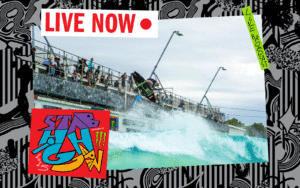5 things that bodyboarders have taught surfers
Words by Sean Marshall | Photos by @russquinnphoto Unlike most sports, it’s common practice for surf media outlets to cross-promote various waveriding codes. Goddamn, Brad Domke’s skimboarding antics are overshadowed on Stab, click-wise, only by a nude Maya Gabeira, or Dane’s new edit. A bit of longboarding never killed anyone, nor did the occasional SUP airdrop at Chopes. And then there’s bodyboarding (*cue long list of burn words* – dick draggers, spongers, lids, speedbumbs). There are very few circumstances that warrant a mention of bodyboarding in our mainstream media. If history is any indicator, it would mean colliding with a dolphin or being dropped in on by Parko’s in Portugal. In no other sport does such a prejudice exist, yet surfers have learned a lot from these prone gents, whether we care to admit it or not. So let’s venture into very dangerous territory and consider five things that bodyboarders have taught us surfers. Most now-famous slabs seemed unsurfable at one time… until someone paddled out. 1. Finding waves… The mere thought of crediting boardboarders with the discovery of a wave is enough to make most surfers convulse, but there are simply too many examples to ignore. Many would be blissfully unaware that it was in fact bodyboarders who first heaved their skeletons into waves like Teahupoo, Cyclops and The Right. Yes, it might be a hard pill to swallow, but through their tenacity and general all-round lunacy, bodyboarders have paved the way for surfers when it comes to many slab discoveries, and received minimal credit in the process. Social media is rife with stories of bodyboarders launching jetskis in the dark and hiding their cars to remain undetected, or surfers studying bodyboarding flicks with their fingers poised over the pause button to find waves. Whether it’s because of their unrivalled passion for the big stuff or a lack of commercial influence, bodyboarders possess a level of persistence that few surfers do, and we can’t help but get out our notepads. The kinda thing you want to keep to yourself. 2. Not blowing them out. Bodyboarders keep their boards close to their chests, and their secrets even closer. Compared to the world of surfing, bodyboarding is an extremely close-knit community, with only a few major companies supporting a handful of top riders. With the sport’s governing body currently undergoing a ‘strategic review’, many have been forced to abandon the competitive scene and forge careers as freesurfers, instead competing for coverage in the few bodyboarding publications that remain. In such a competitive environment, the importance of keeping a spot under wraps is heightened, and bodyboarders have learned to meticulously cover their tracks and travel with people they trust, in the name of exclusivity. But it’s only a matter of time before word gets out. A crew of bodyboarders from Western Australia recently claimed that surf crews would hide on the side of the road for hours on end waiting for them to pass, just so they could be led to the mothership. Do we have spongers to thank for the Power Ranger wetsuit trend of the last three years? 3. Fashion. There’s no doubt that surf fashion has undergone significant change in the past decade, but from where do we draw our inspiration? Skaters? Snowboarders? Emos? Hipsters? There’s a whole gamut of potential sources across the cultural spectrum, but could it be bodyboarders who introduce certain trends into the wave-riding realm? Traditionally, surfers have always maintained an image of being masculine, rugged and nonchalant about their appearance, and so it’s okay that it takes a little longer for certain fashion trends to catch on. The topic of wetsuit fashion is a contentious issue. Of course, radical colourways have drifted in and out of popularity since man first donned rubber, but it’s no secret that for a period of time during the naughties that the plain black suit made a strong revival. Arguably, it was bodyboarding companies that injected some colour back into the industry, flaunting risqué designs such as the zebra and camo, as well as head-to-toe blues, reds and greens. 4. It’s okay to switch crafts. One of the distinct disadvantages of riding a bodyboard is the standard of waves that are required to have fun. Whilst surfers can switch between board lengths and styles to cater to virtually any condition, bodyboarders typically require much steeper and heavier waves to propel their craft and keep things interesting. As a result of this heightened fun threshold, many bodyboarders take up surfing during the summer months or when the conditions are small, to keep themselves emotionally stable. Up until recently, such a move would be scoffed at by many surfers, who would rather be seen at a One Direction concert than with a boog under the arm. But the benefits of bodyboarding easily outweigh the potential scrutiny for Irish surfers Fergal Smith and Hugh Galloway, who are often confronted with waves that are simply too heavy, and short, to find their feet. In the end, it all comes down to practicality for Fergs; “Sometimes 90 percent of the waves are not surfable on a surfboard… and you can wait for that 10 percent, or you can actually have a fun day (on a bodyboard).” Fact: Alex Bunting didn’t claim this wave. 5. Modesty. Whether it’s because of their position in the wave-riding hierarchy or an unexplainable trend in sporting psychology, bodyboarders by nature are much quieter and generally more reserved than surfers. From a surfers’ perspective, this trait could be put down to bodyboarders simply being inferior beings, and lacking in confidence, but the other explanation is that they are in fact more modest about their wave-riding achievements. The general assumption that they are riding a much inferior craft has spawned a public perception of the bodyboarder as being the underdog or darkhorse, which they see as a challenge and a motivator to continue going about their business. The post-barrel claim is virtually unheard of in the bodyboarding world. Perhaps it’s because they need to hold on
Words by Sean Marshall | Photos by @russquinnphoto
Unlike most sports, it’s common practice for surf media outlets to cross-promote various waveriding codes. Goddamn, Brad Domke’s skimboarding antics are overshadowed on Stab, click-wise, only by a nude Maya Gabeira, or Dane’s new edit. A bit of longboarding never killed anyone, nor did the occasional SUP airdrop at Chopes. And then there’s bodyboarding (*cue long list of burn words* – dick draggers, spongers, lids, speedbumbs). There are very few circumstances that warrant a mention of bodyboarding in our mainstream media. If history is any indicator, it would mean colliding with a dolphin or being dropped in on by Parko’s in Portugal. In no other sport does such a prejudice exist, yet surfers have learned a lot from these prone gents, whether we care to admit it or not. So let’s venture into very dangerous territory and consider five things that bodyboarders have taught us surfers.

Most now-famous slabs seemed unsurfable at one time… until someone paddled out.
1. Finding waves…
The mere thought of crediting boardboarders with the discovery of a wave is enough to make most surfers convulse, but there are simply too many examples to ignore. Many would be blissfully unaware that it was in fact bodyboarders who first heaved their skeletons into waves like Teahupoo, Cyclops and The Right. Yes, it might be a hard pill to swallow, but through their tenacity and general all-round lunacy, bodyboarders have paved the way for surfers when it comes to many slab discoveries, and received minimal credit in the process. Social media is rife with stories of bodyboarders launching jetskis in the dark and hiding their cars to remain undetected, or surfers studying bodyboarding flicks with their fingers poised over the pause button to find waves. Whether it’s because of their unrivalled passion for the big stuff or a lack of commercial influence, bodyboarders possess a level of persistence that few surfers do, and we can’t help but get out our notepads.

The kinda thing you want to keep to yourself.
2. Not blowing them out.
Bodyboarders keep their boards close to their chests, and their secrets even closer. Compared to the world of surfing, bodyboarding is an extremely close-knit community, with only a few major companies supporting a handful of top riders. With the sport’s governing body currently undergoing a ‘strategic review’, many have been forced to abandon the competitive scene and forge careers as freesurfers, instead competing for coverage in the few bodyboarding publications that remain. In such a competitive environment, the importance of keeping a spot under wraps is heightened, and bodyboarders have learned to meticulously cover their tracks and travel with people they trust, in the name of exclusivity. But it’s only a matter of time before word gets out. A crew of bodyboarders from Western Australia recently claimed that surf crews would hide on the side of the road for hours on end waiting for them to pass, just so they could be led to the mothership.

Do we have spongers to thank for the Power Ranger wetsuit trend of the last three years?
3. Fashion.
There’s no doubt that surf fashion has undergone significant change in the past decade, but from where do we draw our inspiration? Skaters? Snowboarders? Emos? Hipsters? There’s a whole gamut of potential sources across the cultural spectrum, but could it be bodyboarders who introduce certain trends into the wave-riding realm? Traditionally, surfers have always maintained an image of being masculine, rugged and nonchalant about their appearance, and so it’s okay that it takes a little longer for certain fashion trends to catch on. The topic of wetsuit fashion is a contentious issue. Of course, radical colourways have drifted in and out of popularity since man first donned rubber, but it’s no secret that for a period of time during the naughties that the plain black suit made a strong revival. Arguably, it was bodyboarding companies that injected some colour back into the industry, flaunting risqué designs such as the zebra and camo, as well as head-to-toe blues, reds and greens.
4. It’s okay to switch crafts.
One of the distinct disadvantages of riding a bodyboard is the standard of waves that are required to have fun. Whilst surfers can switch between board lengths and styles to cater to virtually any condition, bodyboarders typically require much steeper and heavier waves to propel their craft and keep things interesting. As a result of this heightened fun threshold, many bodyboarders take up surfing during the summer months or when the conditions are small, to keep themselves emotionally stable. Up until recently, such a move would be scoffed at by many surfers, who would rather be seen at a One Direction concert than with a boog under the arm. But the benefits of bodyboarding easily outweigh the potential scrutiny for Irish surfers Fergal Smith and Hugh Galloway, who are often confronted with waves that are simply too heavy, and short, to find their feet. In the end, it all comes down to practicality for Fergs; “Sometimes 90 percent of the waves are not surfable on a surfboard… and you can wait for that 10 percent, or you can actually have a fun day (on a bodyboard).”

Fact: Alex Bunting didn’t claim this wave.
5. Modesty.
Whether it’s because of their position in the wave-riding hierarchy or an unexplainable trend in sporting psychology, bodyboarders by nature are much quieter and generally more reserved than surfers. From a surfers’ perspective, this trait could be put down to bodyboarders simply being inferior beings, and lacking in confidence, but the other explanation is that they are in fact more modest about their wave-riding achievements. The general assumption that they are riding a much inferior craft has spawned a public perception of the bodyboarder as being the underdog or darkhorse, which they see as a challenge and a motivator to continue going about their business. The post-barrel claim is virtually unheard of in the bodyboarding world. Perhaps it’s because they need to hold on with both hands, or perhaps it’s part of an unwritten law that bodyboarders must remain modest, and self-effacing.

Plenty of surfing’s favourite waves would never have been considered if it weren’t for gents like Matt McArthur taking ’em on first.














Comments
Comments are a Stab Premium feature. Gotta join to talk shop.
Already a member? Sign In
Want to join? Sign Up